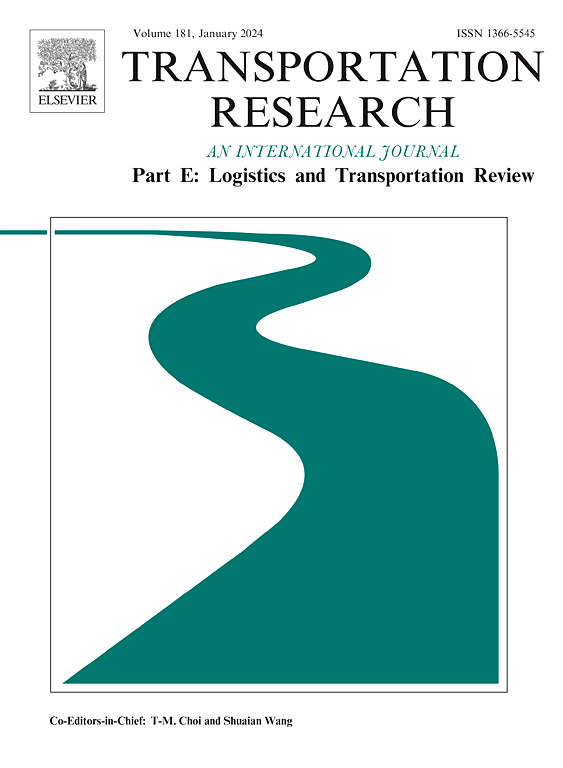Safety aware neural network for connected and automated vehicle operations
IF 8.8
1区 工程技术
Q1 ECONOMICS
Transportation Research Part E-Logistics and Transportation Review
Pub Date : 2024-09-27
DOI:10.1016/j.tre.2024.103780
引用次数: 0
Abstract
Contemporary research in connected and automated vehicle (CAV) operations typically segregates trajectory prediction from planning in two segregated models. Trajectory prediction narrowly focuses on reducing prediction errors, disregarding the implications for subsequent planning. As a result, CAVs adhering to trajectories planned based on such predictions may collide with surrounding traffic. To mitigate such vulnerabilities, this study introduces a holistic safety-aware neural network (SANN) framework, representing a paradigm shift by integrating trajectory prediction and planning into a cohesive model. The SANN architecture incorporates prediction and planning layers, leveraging existing neural networks for prediction and introducing novel recurrent neural cells embedded with car-following dynamics for planning. The prediction layers are regulated by the CAV trajectory planning performance including safety, mobility, and energy efficiency. A key innovation of the SANN lies in its approach to safety regulation, which is based on actual, rather than forecasted, traffic movements. By applying time geography theory, it assesses CAV motion feasibility, setting limits on speed and acceleration for safety in line with actual traffic patterns. This feasibility analysis results are integrated into the neural loss function as a penalty factor, steering the optimization process towards safer CAV operations. The efficacy of the SANN is enhanced by employing the sequential unconstrained minimization technique, which enables the fine-tuning of penalty weights, thereby producing more robust solutions. Empirical evaluations, comparing the holistic SANN with conventional segregated models, demonstrate its superior performance. The SANN achieves substantial enhancements in safety and energy efficiency, with only a marginal compromise on mobility. This success underscores the significance of integrating machine learning with domain knowledge (operations research and traffic flow theory) for safer and more environmentally friendly CAV operations.
用于联网和自动驾驶车辆运行的安全意识神经网络
当代互联与自动驾驶车辆(CAV)运营研究通常将轨迹预测与规划分离为两个独立的模型。轨迹预测狭隘地专注于减少预测误差,而忽略了对后续规划的影响。因此,根据此类预测规划轨迹的 CAV 可能会与周围的交通发生碰撞。为减少此类漏洞,本研究引入了一个整体安全感知神经网络(SANN)框架,通过将轨迹预测和规划整合到一个内聚模型中,实现了范式的转变。SANN 架构包含预测层和规划层,利用现有的神经网络进行预测,并引入嵌入了汽车跟随动力学的新型递归神经单元进行规划。预测层受 CAV 轨迹规划性能(包括安全性、机动性和能效)的制约。SANN 的一个关键创新在于其安全监管方法,即基于实际而非预测的交通流。通过应用时间地理理论,它可以评估 CAV 运动的可行性,并根据实际交通模式设定速度和加速度的安全限制。可行性分析结果作为惩罚因子被整合到神经损失函数中,引导优化过程朝着更安全的 CAV 运行方向发展。通过采用顺序无约束最小化技术,可以对惩罚权重进行微调,从而产生更稳健的解决方案,从而提高 SANN 的功效。通过将整体 SANN 与传统隔离模型进行比较,实证评估证明了 SANN 的卓越性能。SANN 显著提高了安全性和能源效率,但对机动性的影响微乎其微。这一成功强调了将机器学习与领域知识(运筹学和交通流理论)相结合,以实现更安全、更环保的 CAV 运营的重要性。
本文章由计算机程序翻译,如有差异,请以英文原文为准。
求助全文
约1分钟内获得全文
求助全文
来源期刊
CiteScore
16.20
自引率
16.00%
发文量
285
审稿时长
62 days
期刊介绍:
Transportation Research Part E: Logistics and Transportation Review is a reputable journal that publishes high-quality articles covering a wide range of topics in the field of logistics and transportation research. The journal welcomes submissions on various subjects, including transport economics, transport infrastructure and investment appraisal, evaluation of public policies related to transportation, empirical and analytical studies of logistics management practices and performance, logistics and operations models, and logistics and supply chain management.
Part E aims to provide informative and well-researched articles that contribute to the understanding and advancement of the field. The content of the journal is complementary to other prestigious journals in transportation research, such as Transportation Research Part A: Policy and Practice, Part B: Methodological, Part C: Emerging Technologies, Part D: Transport and Environment, and Part F: Traffic Psychology and Behaviour. Together, these journals form a comprehensive and cohesive reference for current research in transportation science.

 求助内容:
求助内容: 应助结果提醒方式:
应助结果提醒方式:


